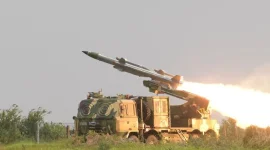- Views: 4K
- Replies: 11
India's Defence Research and Development Organisation (DRDO) is developing a sophisticated new technology known as the Multiple Kill Vehicle (MKV) system to fortify the nation's ballistic missile defence shield.
This advanced initiative is aimed at neutralising missile attacks from Multiple Independently Targetable Reentry Vehicles (MIRVs), a complex threat where a single missile carries several warheads capable of striking different targets.
A MIRV-equipped missile can release multiple warheads and decoys in the final phase of its trajectory, making it difficult for conventional missile defence systems to intercept each threat effectively.
The MKV system is being engineered specifically to overcome this challenge.
The technology involves a ground-launched interceptor missile that carries a single carrier vehicle. This carrier, guided by a high-resolution telescope, is designed to release several smaller, autonomous "kill vehicles" in the path of the incoming warheads.
Each of these small interceptors will then independently track and destroy its assigned target in the terminal phase of the attack, just before it re-enters the atmosphere.
The core strategy behind the MKV project is to overwhelm an incoming missile strike with superior numbers. By launching a swarm of kill vehicles from a single interceptor, the system significantly increases the probability of destroying all incoming enemy warheads.
This approach lessens the difficult task of discriminating between lethal warheads and non-lethal decoys, as the system can simply target all suspicious objects.
This "high-firepower" method is a critical upgrade to India's existing two-tiered Ballistic Missile Defence (BMD) programme.
The development of a robust defence against MIRVs is strategically vital, especially as several nations, including some in India's neighbourhood, have developed or are developing this capability.
The successful deployment of the MKV system would represent a major leap in India's strategic defence infrastructure.
It underscores a national commitment to creating a credible deterrence posture and will position India among a small group of nations with the technology to counter such advanced missile threats.
The system will undergo extensive and rigorous testing to confirm its reliability and effectiveness before its eventual integration into the armed forces.


